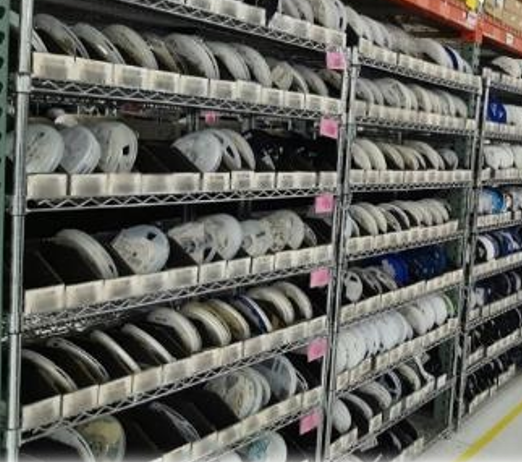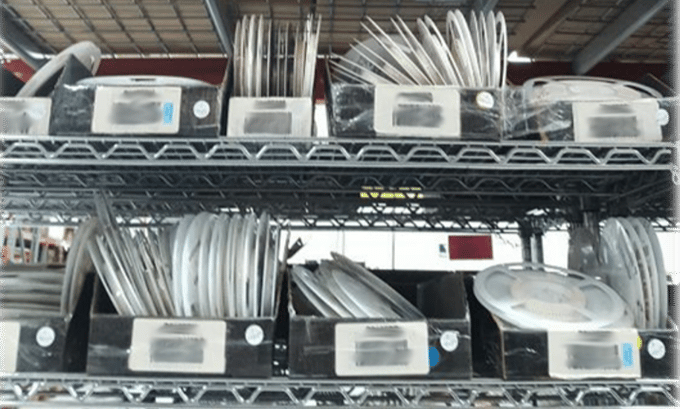Until recent years, most manufacturers have only ever had one way to store their SMT material: rack-and-bin storage. Just like the name implies, this methodology typically involves off-the-shelf metal racks and cardboard or plastic bins to store parts. Although this is the de facto standard for storing material, it can hurt manufacturers in a number of ways, including wasting space, incurring excess labor costs, and increasing human errors and inventory inaccuracy.
What is Rack-and-Bin Storage
Generally speaking, rack-and-bin storage allocates fixed bin locations to one or more part numbers. It's organized such that you always have a specific location where any particular part number belongs in a stockroom or warehouse. These bins are labeled, often with a barcode, so that operators can identify a location when picking or putting away material.
If you think about it, this basic methodology is the standard way that humans organize their things. We like to allocate specific spaces to specific items so that we can create simple 'maps' in our heads. A grocery store has a cereal aisle with a particular location for Frosted Flakes, your kitchen probably has a silverware drawer with designated locations for forks and knives, and so on.
This type of storage system is easy to implement and expand upon and requires relatively small up-front capital expenditures, but this system can be rife with inefficiencies that will cause manufacturers endless headaches. Let's look at a few problems with rack-and-bin storage.
Static Locations Cause Wasted Space
One of the most basic aspects of rack-and-bin storage is the static allocation of storage locations: assigning one or more part numbers to a particular bin or box. By assigning a specific location to a specific part number, you are holding that location's volume open regardless of the quantity of parts on hand at any given time. Go through any standard rack-and-bin stockroom and you're bound to find bins that are completely empty - just waiting for the right parts to come along. Most other bins may have one or two SMT reels, wasting the rest of that bin's potential storage space.
 Typical rack-and-bin storage, wasted space and all. Look familiar?
Typical rack-and-bin storage, wasted space and all. Look familiar?
It may be hard to believe, but storage space like the image above can be reduced by up to 90% with modern Smart Storage Systems that dynamically allocate their storage locations. This kind of space savings is not just a nice convenience; it can truly revolutionize a manufacturing operation.
In addition to drastically reducing the time and energy spent traversing a large stockroom, reducing storage space by 90% allows manufacturers to reimagine their entire material operation in a number of ways. From freeing up space for value-added operations to eliminating your stockroom altogether and moving all your material to the production line - the opportunities are endless.
Storing Packages Together Wastes Labor and Causes Errors
Even if you have each bin filled to capacity in order to minimize wasted space, by storing multiple packages in the same location you require operators to manually sort through the bin to find the correct packages when picking.
 Which is the oldest reel? The right manufacturer? The right quantity?
Which is the oldest reel? The right manufacturer? The right quantity?
This is one of the major reasons that picking in a rack-and-bin operation can be so time consuming. Imagine those bins are full of different manufacturers, different date codes, different partial quantities. Operators have to go through reel-by-reel so they can find the correct reels for any particular job. On top of the time it takes to find the right reel(s), it is very easy for any operator to make a mistake by picking the wrong manufacturer, the wrong quantity, a new reel, and so on.
Smart Storage Systems eliminate these issues altogether by automatically selecting the exact packages required for each operation. Whether it is adhering to AVLs, selecting customer-specific inventory, following FIFO, or any other picking scheme, Smart Storage does the work for you.
Manual Data Entry Wastes Time
On top of the time wasted simply finding the right parts, it's usually necessary to manually enter all picks into ERP/MRP/MES systems, either by hand or with multiple barcode scans. Manual entry can, of course, introduce more human errors due to typos in addition to adding time to each individual pick.
Modern material handling systems with integration capabilities can manage these operations for you, ensuring that all your systems are up to date with exactly what was picked for each job. With two-way data integration, jobs and picks are automatically sent back and forth, eliminating manual data entry and human errors while reducing overall material handling time by up to 90%.
Smart Storage Is The Answer
While rack-and-bin storage provides a cheap up-front cost, you will end up spending far more on labor and errors over time. Smart Storage Solutions, like InoAuto, not only cure your immediate material handling headaches, but provide practically instant ROI by eliminating wasted space and labor while automating data flow through integrations. Inovaxe can help modernize any operation, from small EMS shops to ultra-high-volume automotive operations - and everything in between.
Check out our testimonials page, this case study from DELTEC, or watch our overview video, to see just how our systems can revolutionize your operations. And don't forget to enter your email below to get updates when new blogs are posted! Coming up next we'll go through exactly what we mean by Smart Storage.